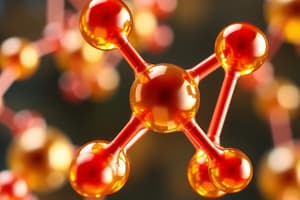Podcast
Questions and Answers
Which of the following is NOT a factor influencing the rate of a chemical reaction?
Which of the following is NOT a factor influencing the rate of a chemical reaction?
- Temperature
- Concentration of reactants
- The nature of the reactants
- The color of the reactants (correct)
Which of the following is an example of a heterogeneous mixture?
Which of the following is an example of a heterogeneous mixture?
- Air
- Salt water
- Sand and water (correct)
- Sugar dissolved in water
What is the pH of a solution with a hydrogen ion concentration of $10^{-4}$ M?
What is the pH of a solution with a hydrogen ion concentration of $10^{-4}$ M?
- 10^-4
- 10
- 14
- 4 (correct)
Which of the following is a characteristic of a buffer solution?
Which of the following is a characteristic of a buffer solution?
Which type of radioactive decay results in the emission of a helium nucleus?
Which type of radioactive decay results in the emission of a helium nucleus?
What is the relationship between entropy and spontaneity?
What is the relationship between entropy and spontaneity?
Which of the following is a correct statement about the first law of thermodynamics?
Which of the following is a correct statement about the first law of thermodynamics?
What is the main difference between a solid and a liquid?
What is the main difference between a solid and a liquid?
Which of the following statements accurately describes the relationship between atomic number and the identity of an element?
Which of the following statements accurately describes the relationship between atomic number and the identity of an element?
Which of the following statements best describes the formation of an ionic bond?
Which of the following statements best describes the formation of an ionic bond?
In a chemical reaction, what is the role of a catalyst?
In a chemical reaction, what is the role of a catalyst?
What is the primary difference between a covalent bond and a polar covalent bond?
What is the primary difference between a covalent bond and a polar covalent bond?
Which of the following statements accurately describes the Aufbau principle for electron configuration?
Which of the following statements accurately describes the Aufbau principle for electron configuration?
Which type of chemical bond is responsible for the strong attraction between water molecules?
Which type of chemical bond is responsible for the strong attraction between water molecules?
What is the main reason for the difference in chemical properties between sodium (Na) and chlorine (Cl)?
What is the main reason for the difference in chemical properties between sodium (Na) and chlorine (Cl)?
Which of the following factors can influence the rate of a chemical reaction?
Which of the following factors can influence the rate of a chemical reaction?
Flashcards
Atomic Structure
Atomic Structure
Atoms are building blocks of matter, with nucleus (protons/neutrons) and electrons.
Protons
Protons
Positively charged particles in an atom's nucleus that define the atomic number.
Isotopes
Isotopes
Atoms of the same element with different numbers of neutrons and atomic masses.
Aufbau Principle
Aufbau Principle
Signup and view all the flashcards
Ionic Bonds
Ionic Bonds
Signup and view all the flashcards
Covalent Bonds
Covalent Bonds
Signup and view all the flashcards
Chemical Reactions
Chemical Reactions
Signup and view all the flashcards
Reaction Rates
Reaction Rates
Signup and view all the flashcards
Equilibrium Reactions
Equilibrium Reactions
Signup and view all the flashcards
States of Matter
States of Matter
Signup and view all the flashcards
Solvent vs Solute
Solvent vs Solute
Signup and view all the flashcards
pH Scale
pH Scale
Signup and view all the flashcards
First Law of Thermodynamics
First Law of Thermodynamics
Signup and view all the flashcards
Activation Energy
Activation Energy
Signup and view all the flashcards
Radioactivity
Radioactivity
Signup and view all the flashcards
Buffer Solutions
Buffer Solutions
Signup and view all the flashcards
Study Notes
Atomic Structure
- Atoms are the fundamental building blocks of matter, composed of a nucleus containing protons and neutrons, surrounded by orbiting electrons.
- Protons carry a positive charge, neutrons are neutral, and electrons carry a negative charge.
- The number of protons in an atom's nucleus defines its atomic number, which determines the element.
- Isotopes are atoms of the same element with different numbers of neutrons, resulting in different atomic masses.
- Atomic orbitals describe the probability of finding an electron in a specific region around the nucleus. Different orbitals have different shapes and energy levels.
- Electrons fill orbitals in a specific order, following the Aufbau principle, Hund's rule, and the Pauli exclusion principle.
- The electron configuration describes the arrangement of electrons in an atom's orbitals, which influences the atom's chemical properties.
Chemical Bonding
- Chemical bonds form when atoms interact to achieve a stable electron configuration, typically a full outer electron shell.
- Ionic bonds form between metals and nonmetals, involving the transfer of electrons to create oppositely charged ions.
- Covalent bonds form between nonmetals, involving the sharing of electrons between atoms.
- Metallic bonds form between metal atoms, involving the delocalization of electrons across a "sea" of electrons.
- Polar covalent bonds occur when electrons are shared unequally between atoms, resulting in a dipole moment.
- Hydrogen bonds are a special type of dipole-dipole interaction involving a hydrogen atom bonded to a highly electronegative atom (like oxygen or nitrogen) and another electronegative atom. They are crucial in many biological molecules.
Chemical Reactions
- Chemical reactions involve the rearrangement of atoms to form new substances.
- Reactants are the substances that undergo change, and products are the substances formed.
- The law of conservation of mass states that mass is neither created nor destroyed in a chemical reaction. The number of atoms of each element on both sides of the equation must be equal.
- Chemical equations represent chemical reactions using formulas of reactants and products and balancing coefficients.
- Reaction rates describe how quickly reactants transform into products. Factors like temperature, concentration, and catalysts can influence reaction rates.
- Types of chemical reactions include synthesis, decomposition, single replacement, double replacement, and combustion. Each type has a characteristic pattern.
- Equilibrium reactions are reversible reactions where the forward and reverse reactions proceed at the same rate. The ratio of products to reactants at equilibrium is described by the equilibrium constant (Keq).
States of Matter
- Matter exists in solid, liquid, and gaseous phases.
- Solids have fixed shapes and volumes due to strong intermolecular forces holding particles in a rigid structure.
- Liquids have definite volumes but take the shape of their container due to weaker intermolecular forces.
- Gases have neither fixed shapes nor volumes, and their particles are widely dispersed with weak intermolecular forces.
- Changes of state, like melting, freezing, vaporization, condensation, and sublimation, involve energy changes related to the strength of intermolecular forces and temperature.
Solutions
- Solutions are homogeneous mixtures of two or more substances.
- The solvent is the substance present in the largest amount, and the solute is the substance dissolved in the solvent.
- Solubility is the ability of a substance to dissolve in a solvent, influenced by temperature, pressure, and intermolecular forces.
- Concentration expresses the amount of solute in a given amount of solution, using units like molarity, molality, and percent by mass.
Acids and Bases
- Acids are substances that donate protons (H+ ions) in solution, and bases are substances that accept protons.
- The pH scale measures the acidity or basicity of a solution, ranging from 0 (strongly acidic) to 14 (strongly basic).
- Neutralization reactions occur when acids and bases react to form water and a salt.
- Buffers are solutions that resist changes in pH when small amounts of acid or base are added.
Thermodynamics
- Thermodynamics studies energy transfer and transformations in chemical and physical processes.
- The first law of thermodynamics states that energy cannot be created or destroyed, only transformed.
- The second law of thermodynamics states that the entropy (disorder) of the universe tends to increase in spontaneous processes.
- The third law of thermodynamics states that the entropy of a perfect crystal at absolute zero is zero.
Kinetics
- Kinetics studies the rates of chemical reactions and the factors affecting them.
- Reaction mechanisms describe the step-by-step process of a chemical reaction.
- Reaction rates depend on factors like temperature, concentration, and presence of catalysts.
- Activation energy is the minimum energy required for a reaction to occur.
Nuclear Chemistry
- Nuclear chemistry deals with changes in the nucleus of an atom.
- Radioactivity is the spontaneous emission of particles or energy from the nucleus of an unstable atom.
- Radioactive decay follows first-order kinetics.
- Nuclear reactions can release massive amounts of energy, used in nuclear power plants and weapons.
- Different types of radioactive decay include alpha, beta, and gamma.
Studying That Suits You
Use AI to generate personalized quizzes and flashcards to suit your learning preferences.




